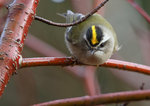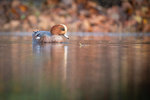


In 1900 Frank Chapman, an ornithologist in New York City, proposed to his friends that they go out on Christmas Day and do a bird census. Thus started an annual bird-watching tradition that continues to this day.
The count is now an official function of the National Audubon Society, and you can read all about it on the society’s website. The count must occur between December 14 and January 5. Local groups define a count area – most are 15-mile diameter circles – and establish a count day. Then it’s a matter of organizing participant volunteers and compiling the count data, which are no small tasks.
Our Olympia Christmas Bird Count (CBC) has been conducted almost every year since the 1940s and is organized by our local Audubon chapter, the Black Hills Audubon Society. Our area’s circle centers on a point near South Bay Rd. and 26th Ave. and stretches from the Nisqually Delta on the east to Eld Inlet on the west. It begins in the predawn hours with hardy birders listening for owls.
This large area is divided into sub-areas. People organize a count team for their sub-area and specific routes within a sub-area. The entire day’s work is compiled into a summary report of the total species seen or heard and totals for each species. In addition to numbers, participants also report hours and miles covered to document overall effort since this can influence count numbers from year to year. We expect about 125 species to be found during the Olympia CBC each year.
How many people are out there counting?
I love participating in the Olympia CBC and was the count coordinator in years past. Visiting the same locations annually at about the same date helps me better understand nature, and both constancy and change. I walk along thinking “there is usually a mixed flock of kinglets and chickadees along this path,” and amazingly enough there they are again (usually).
On count day, I pay close attention to species I might ignore at other times. Golden-crowned Kinglets, small birds that hang out in the tops of conifers, are difficult to count and easy to ignore, but not on count day. I usually just estimate flock size by vocalizations. But one year, the flock flew from one side of the road to the other, and I confirmed my flock size estimate of 40.
Of course, we’re all on the lookout for unusual species. Most years, there are a few Townsend’s and Orange-crowned warblers in the area. Some years the Nisqually counters spot a Eurasian Wigeon joining the flocks of American Wigeons.
One or two of the Olympia CBC count teams go out into marine waters on a good-sized boat. They spend the day cruising Budd Inlet, outer Henderson Inlet and the Nisqually Reach. Several count area species – Common Murre, Rhinoceros Auklet and a few others - only occur in marine waters. In some years, major ocean storms drive smaller pelagic birds into the more sheltered waters of Puget Sound. This year Liam, our column photographer, will be on a boat in marine waters.
The Olympia CBC this year is Sunday, December 18. Details about possible participation are found on the Black Hills Audubon Society website.
Do this from home
A great way to contribute for stay-near-home folks is a feeder count. Simply count the maximum numbers, by species, the visit your feeder on December 18 and report your numbers, along with your location. You want to try not to duplicate your count – those four nuthatches that visit in the morning are probably the same four that visit again in the afternoon. You can send your count numbers to me, or directly to the BHAS count coordinator.
Feeder counts are critically important to the total count. Those California Quails that visit you early in the morning might be the only ones seen on count day. The rarely-seen White-throated Sparrow is often only counted when visiting one of our local feeders. And, of course, it’s a great way to accurately census how many Anna’s Hummingbirds are “wintering in Olympia.”
George Walter is the environmental program manager at the Nisqually Indian Tribe’s natural resources department; he also has a 40+ year interest in bird watching. He may be reached at george@theJOLTnews.com
Photos for this column are provided by Liam Hutcheson, a 15-year-old Olympia area birder and avid photographer.
Comments
No comments on this item Please log in to comment by clicking here